A New 4 × 4 Rectangular Waveguide Short-Slot Coupler in 3D Printed Technology at Ku-Band
Abstract
:1. Introduction
2. Theory and Design
3. Experimental Prototype with Additive Manufacturing and Results
4. Conclusions
Author Contributions
Funding
Acknowledgments
Conflicts of Interest
References
- Uher, J.; Bornerman, J.; Rosenberg, U. Waveguide Components for Antenna Feed Systems: Theory and CAD; Artech House: Boston, MA, USA, 1993. [Google Scholar]
- Riblet, H.J. The Short-Slot Hybrid Junction. Proc. IRE 1948, 40, 180–184. [Google Scholar] [CrossRef]
- Alessandri, F.; Ravanelli, R. A New Class of Dual-Mode Directional Couplers for Compact Dual-Polarization Beam-Forming Networks. IEEE Microw. Guid. Wave Lett. 1997, 7, 300–301. [Google Scholar] [CrossRef]
- Ruiz-Cruz, J.A.; Montejo-Garai, J.R.; Rebollar, J.M. Short-slot E- and H-plane waveguide couplers with an arbitrary power division ratio. Int. J. Electron. 2011, 98, 11–24. [Google Scholar] [CrossRef]
- Alessandri, F.; Giordano, M.; Guglielmi, M.; Martirano, G.; Vitulli, F. A New Multiple-Tuned Six-Port Riblet- Type Directional Coupler in Rectangular Waveguide. IEEE Trans. Microw. Theory Tech. 2003, 51, 1441–1448. [Google Scholar] [CrossRef]
- Fonseca, N.J.G.; Petrolati, D.; Angeletti, P. Design of a Waveguide Dual-Mode Three-Way Power Divider for Dual-Polarization Beam Forming Networks at Ka-Band. In Proceedings of the 2013 IEEE Antennas and Propagation Society International Symposium (APSURSI), Orlando, FL, USA, 7–13 July 2013; pp. 1096–1097. [Google Scholar]
- Morini, A.; Baldelli, M.; Angeletti, P.; Petrolati, D.; Toso, G.; Venanzoni, G. Directional Coupler with 3 Input / 3 Output Square Waveguide Dual-Polarization Ports. In Proceedings of the 12th European Conference on Antennas and Propagation (EuCAP 2018), London, UK, 9–13 April 2018; pp. 1–4. [Google Scholar]
- Kim, D.H.; Hirokawa, J.; Ando, M. Design of Waveguide Short-Slot Two-Plane Couplers for One-Body 2-D Beam-Switching Butler Matrix Application. IEEE Trans. Microw. Theory Tech. 2016, 64, 776–784. [Google Scholar] [CrossRef]
- Hirokawa, J.; Kim, D.; Wakasa, M.; Sunaguchi, Y.; Tomura, T.; Nishimori, K. Measurements of a 64x64-way One-body Two-dimensional Beam-switching Hollow-waveguide Butler Matrix. In Proceedings of the 2018 48th European Microwave Conference EuMW, Madrid, Spain, 23–27 September 2018; pp. 125–128. [Google Scholar]
- Ahmadi, S. 5G Arquitecture, Technology, Implementation, and Operation of 3GPP New Radio Standards; Elsevier: London, UK, 2019; pp. 566–586. [Google Scholar]
- Razavizadeh, S.M.; Ahn, M.; Lee, I. Three-Dimensional Beamforming. IEEE Signal Process. Mag. 2014, 94, 94–101. [Google Scholar] [CrossRef]
- Conciauro, C.; Guglielmi, M.; Sorrentino, R. Advanced Modal Analysis: CAD Techniques for Waveguide Components and Filters; John Wiley: Hoboken, NJ, USA, 1999. [Google Scholar]
- Alessandri, F.; Bartolucci, G.; Sorrentino, R. Admittance matrix formulation of waveguide discontinuity problems: Computer aided design. IEEE Trans. Microw. Theory Tech. 1988, 36, 394–403. [Google Scholar] [CrossRef]
- Rebollar, J.M.; Esteban, J.; Page, J.E. Fullwave analysis of three and four-port rectangular waveguide juctions. IEEE Trans. Microw. Theory Tech. 1994, 42, 256–273. [Google Scholar] [CrossRef]
- Ruiz-Cruz, J.A.; Montejo-Garai, J.R.; Rebollar, J.M. Computer Aided Design of Waveguide Devices by Mode-Matching Methods; Intechopen: London, UK, 2010; pp. 1–26. [Google Scholar] [CrossRef] [Green Version]
- Moscato, S.; Bahr, R.; Le, T.; Pasian, M.; Bozzi, M.; Perregrini, L.; Tentzeris, M.M. Additive manufacturing of 3D substrate integrated waveguide components. Electron. Lett. 2015, 51, 1426–1428. [Google Scholar] [CrossRef]
- Tamayo-Dominguez, A.; Fernández, J.M.; Sierra-Perez, M. Groove Gap Waveguide in 3-D Printed Technology for Low Loss, Weight, and Cost Distribution Networks. IEEE Trans. Microw. Theory Tech. 2017, 65, 4138–4147. [Google Scholar] [CrossRef]
- Shen, J.; Aiken, M.; Ladd, C.; Dickey, M.D.; Ricketts, D.S. A simple electroless plating solution for 3D printed microwave components. In Proceedings of the 2016 Asia-Pacific Microwave Conference, New Delhi, India, 5–9 December 2016. [Google Scholar]
- Montejo-Garai, J.R.; Ruiz-Cruz, J.A.; Rebollar, J.M. Full-Wave Design of H-Plane Contiguous Manifold Output Multiplexers Using the Fictitious Reactive Load Concept. IEEE Trans. Microw. Theory Tech. 2005, 53, 2628–2632. [Google Scholar] [CrossRef]
- Montejo-Garai, J.R.; Ruiz-Cruz, J.A.; Rebollar, J.M. Efficient Design of Contiguous-Band Elliptic-Response Manifold Output Multiplexers with Single-Terminated Filters. Electromagnetics 2010, 30, 644–659. [Google Scholar] [CrossRef]
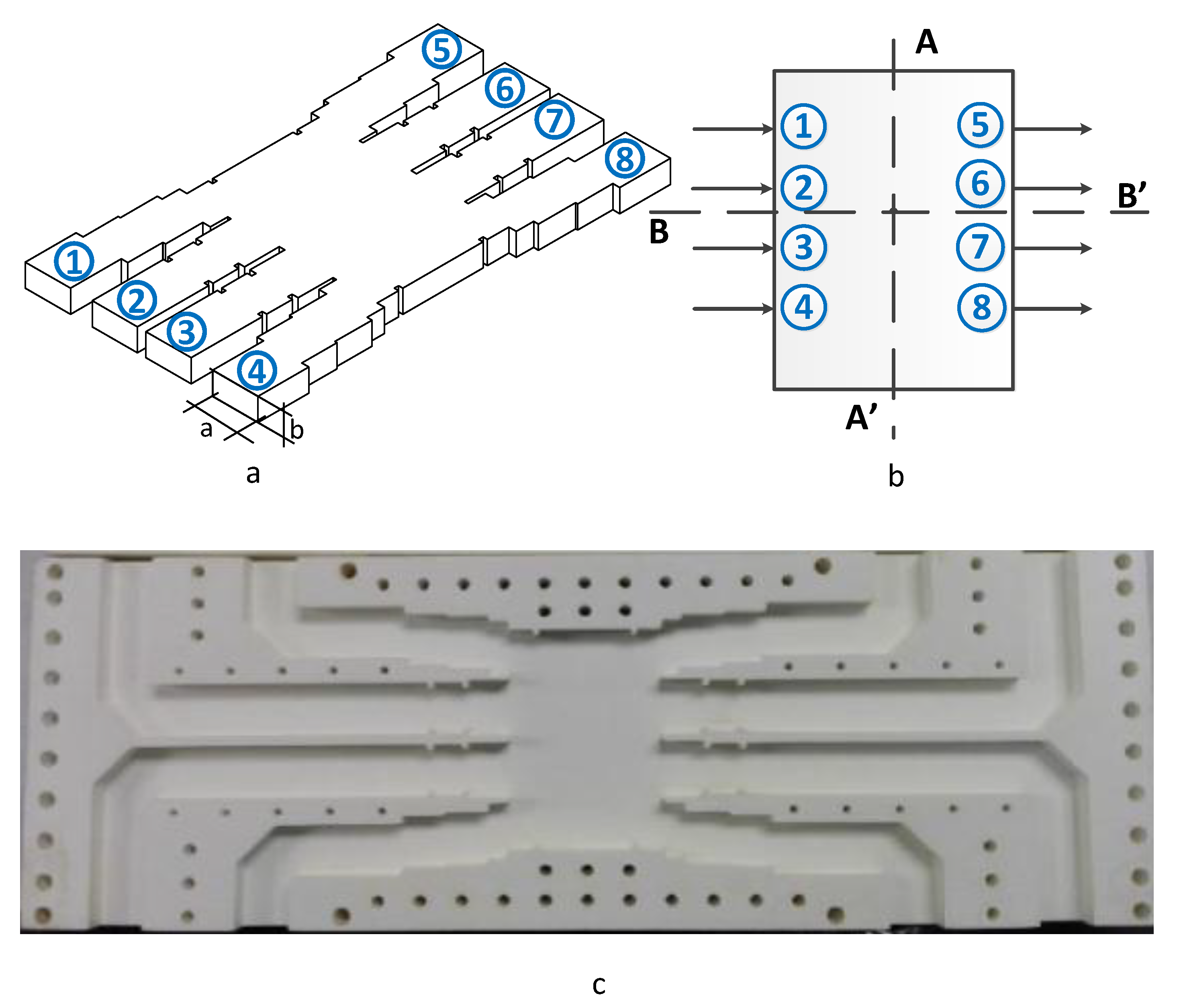
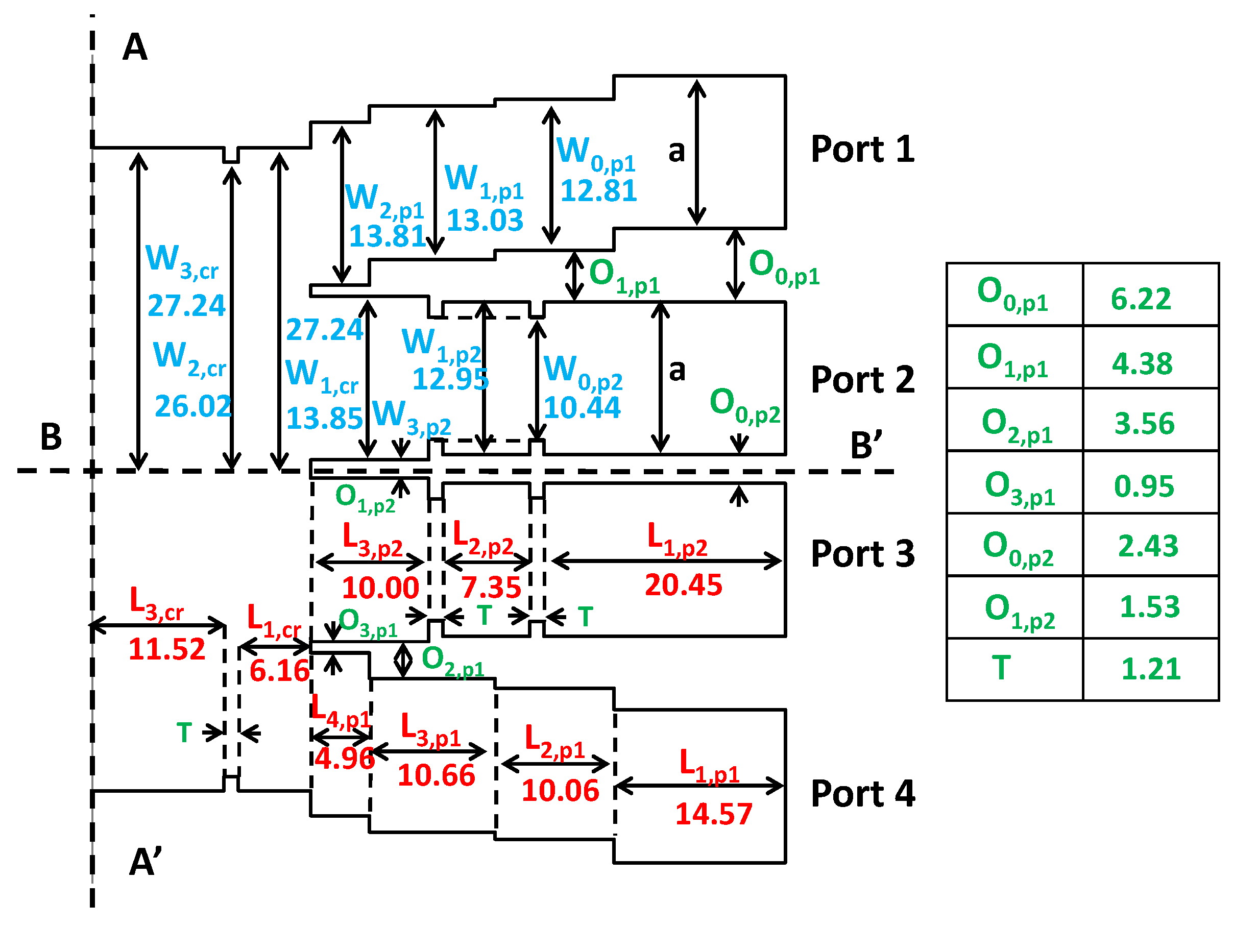

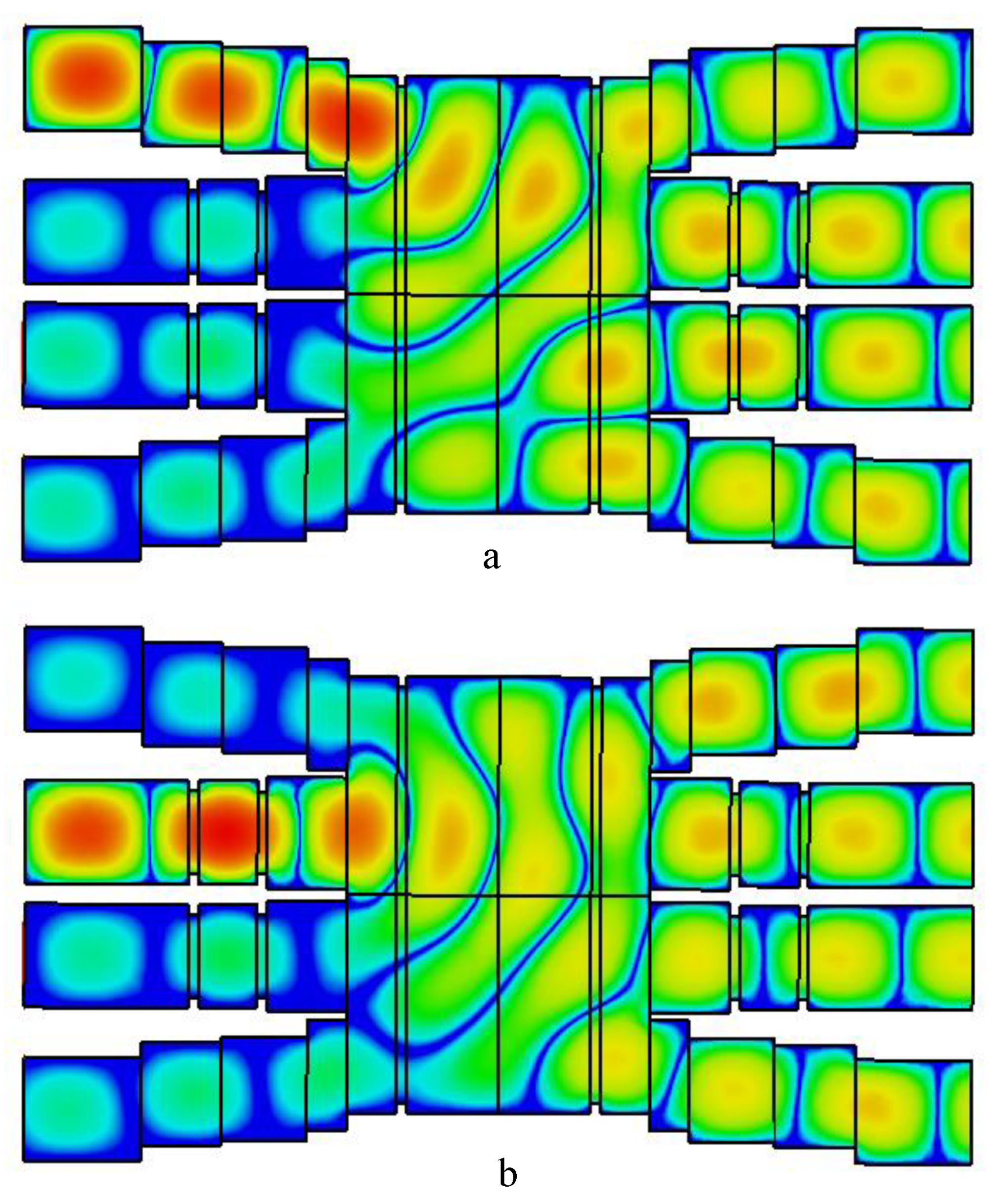
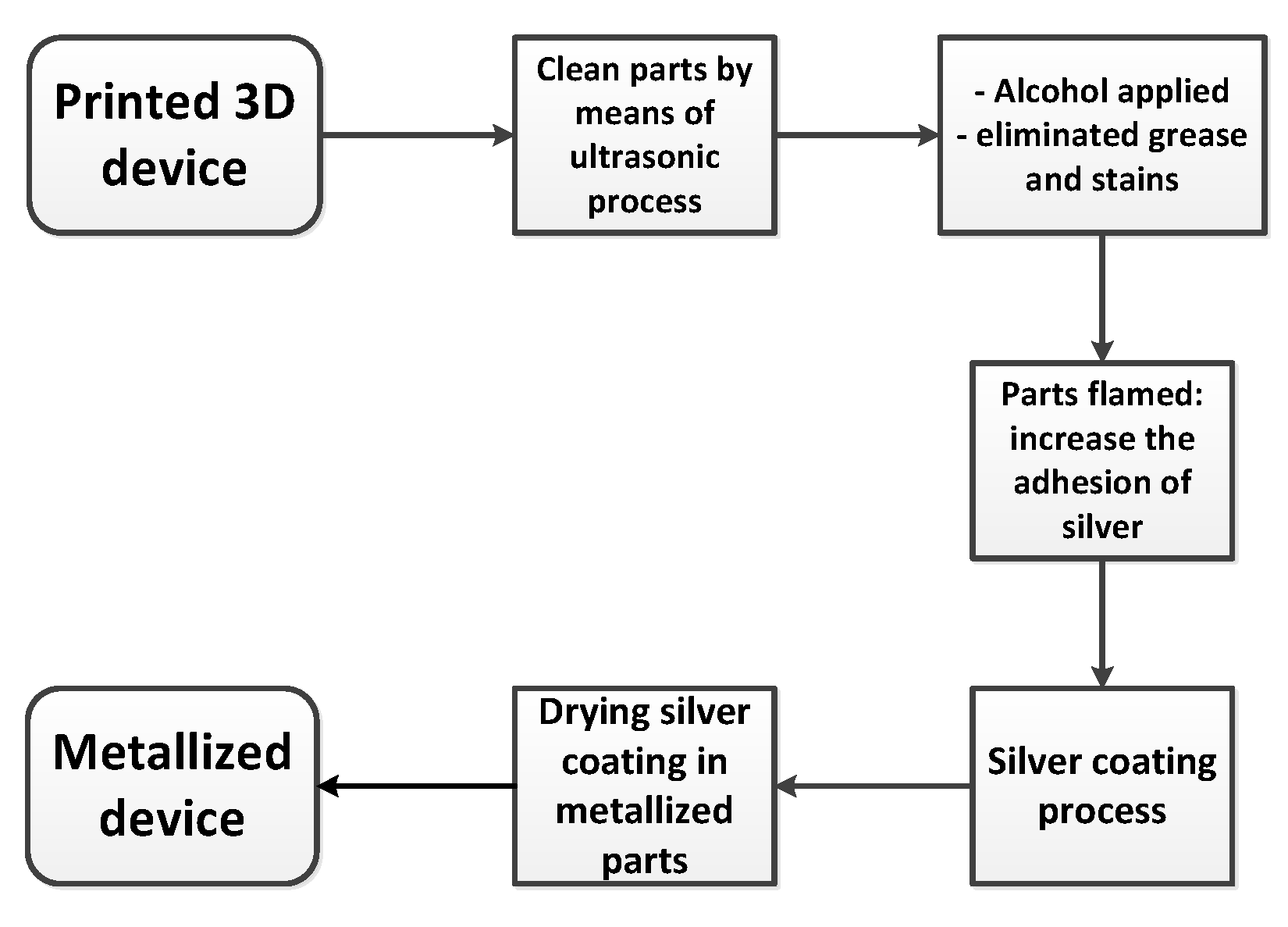
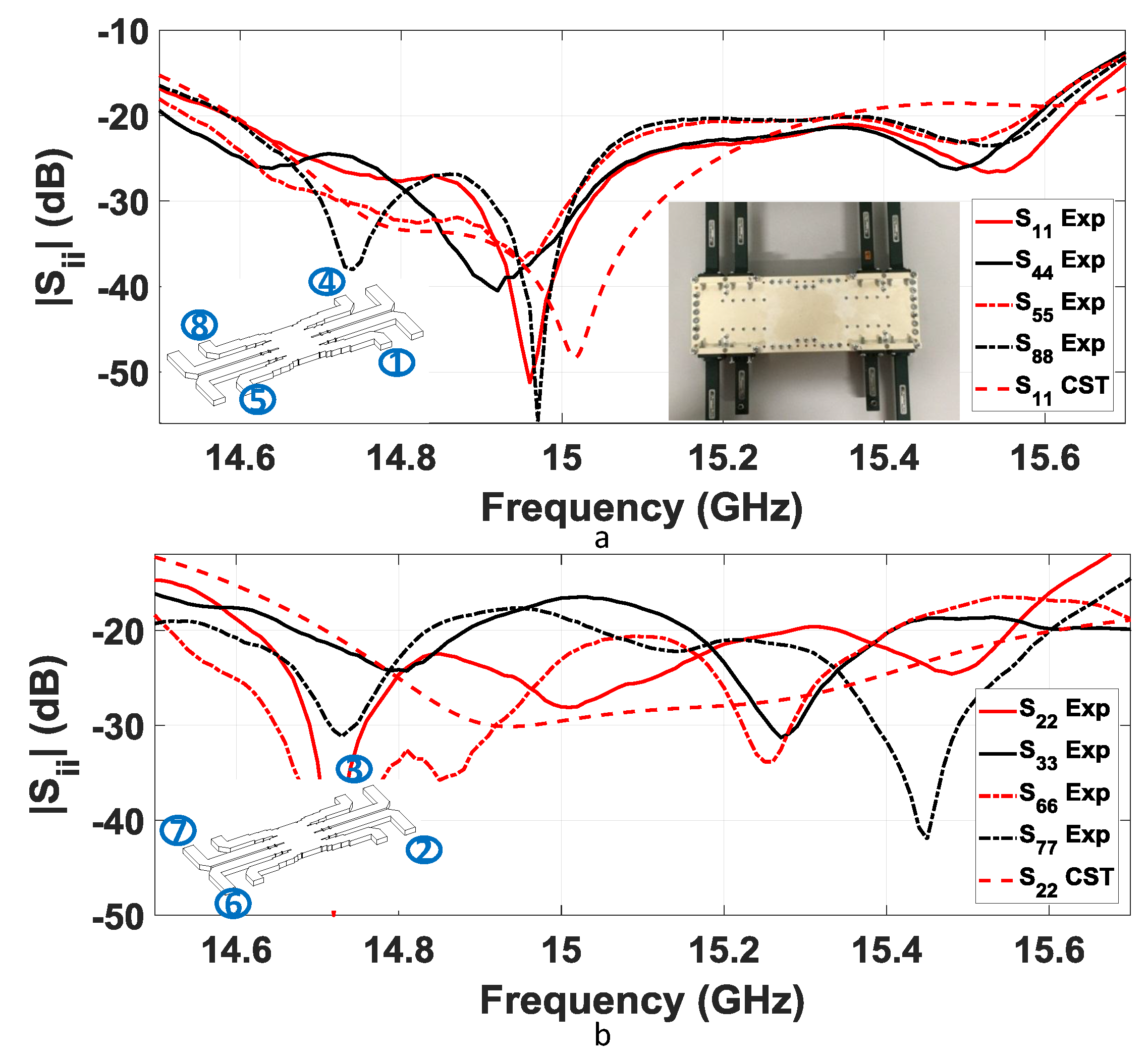
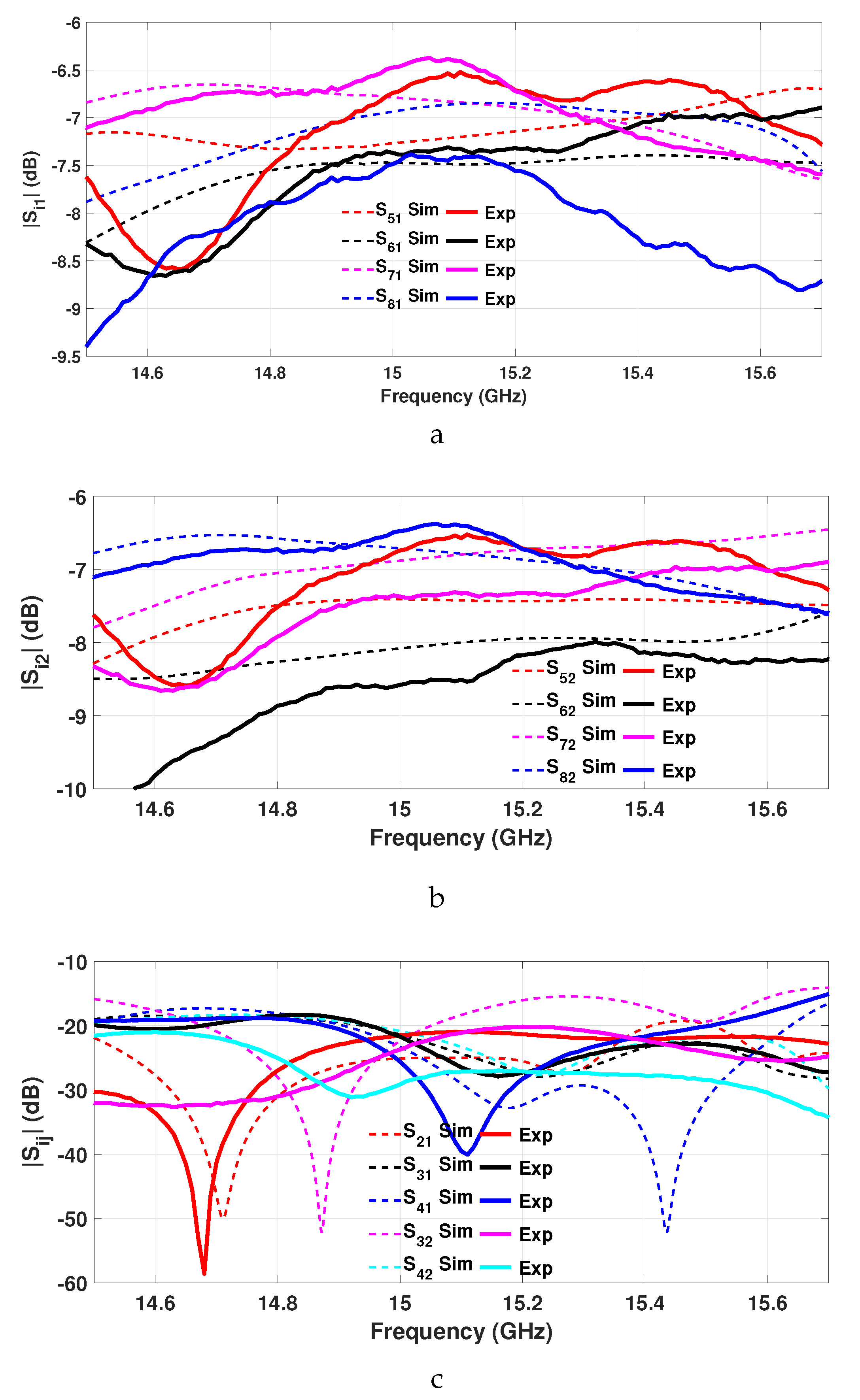

| Specifications | Requirements |
|---|---|
| Number of Ports | 8 |
| Central Frequency | 15.1 GHz Ku band |
| Bandwidth | 1 GHz |
| Return Loss | < 20 dB |
| Isolation | < 20 dB |
| Coupling Values | 6.02 ± 1 dB |
| Interface | Waveguide WR-51 |
| Ref. | BW (%) | Return Loss (dB) | Coupling. (dB) | No. of Phy./Elec. Ports | Size |
|---|---|---|---|---|---|
| [4] | 15.0 | 25.0 | −3.01 ± 0.5 | 4/4 | Low |
| [3] | 8.3 | 25.0 | −3.01 ± 0.5 | 4/8 | Low |
| [5] | 8.4 | 20.0 | −4.77 ± 1.0 | 6/6 | High |
| [6] | 10.0 | 20.0 | −4.77 ± 1.0 | 6/12 | Medium |
| [8] | 2.3 | 18.5 | −6.02 ± 1.0 | 8/8 | Medium |
| TW | 6.6 | 20.0 | −6.02 ± 1.0 | 8/8 | Medium |
© 2020 by the authors. Licensee MDPI, Basel, Switzerland. This article is an open access article distributed under the terms and conditions of the Creative Commons Attribution (CC BY) license (http://creativecommons.org/licenses/by/4.0/).
Share and Cite
Haro-Baez, R.V.; Ruiz-Cruz, J.A.; Córcoles, J.; Montejo-Garai, J.R.; Rebollar, J.M. A New 4 × 4 Rectangular Waveguide Short-Slot Coupler in 3D Printed Technology at Ku-Band. Electronics 2020, 9, 610. https://doi.org/10.3390/electronics9040610
Haro-Baez RV, Ruiz-Cruz JA, Córcoles J, Montejo-Garai JR, Rebollar JM. A New 4 × 4 Rectangular Waveguide Short-Slot Coupler in 3D Printed Technology at Ku-Band. Electronics. 2020; 9(4):610. https://doi.org/10.3390/electronics9040610
Chicago/Turabian StyleHaro-Baez, Raúl V., Jorge A. Ruiz-Cruz, Juan Córcoles, José R. Montejo-Garai, and Jesús M. Rebollar. 2020. "A New 4 × 4 Rectangular Waveguide Short-Slot Coupler in 3D Printed Technology at Ku-Band" Electronics 9, no. 4: 610. https://doi.org/10.3390/electronics9040610





